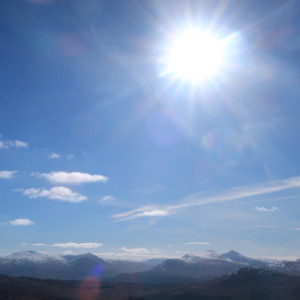Ben Nevis and the Grey Corries from Glen Roy
Spent last night camping in Glen Roy. B+M have a nice comfy camper van but I was relegated to my tent on a beautiful starry night with Orion prominent in the west. It was however -3C and my forty year old 5 season sleeping bag isn't what it used to be. I spent a cool night with my woolly hat on.
Woke at 7am to a strange animal sound, a bit like a high pitch pigeon cooing or warbling. I cracked open the fly sheet of the tent and was showered with bits of ice in the process but was rewarded with the sight of four large black birds, about 300 yards away performing a dance in the early morning Sun on the open hllside. Two of them were facing each other and jumping three or four feet into the air, flapping their wings and showing off their white rumps. Black Grouse are famous for their mating dance (called lekking) but I had never seen it before, in fact I had never seen a Black Grouse before. Unfortunately I didn't have my big lens and they were too far away for a photograph
A fantastic start to another great day on the hill. We did another 'Graham', Leana Mhor on the SE side of Glen Roy and a 'Corbet', Carn Dearg. Today's blip is a panorama of Ben Nevis and the Grey Corries, Ben Nevis and Aonach Mor on the right and Stop Choire Claurigh on the left. The first extra is another shot of the Grey Corries to the south, into the Sun.
Glen Roy is also famous for its 'parallel roads' (see second extrra). These are a glacial feature from the last ice-age 12-15,000 years ago and mark the shores of a glacial lake that fluctuated in height and left three distinct shore lines. Darwin visited Glen Roy and thought they might be the shore of an ancient sea, but that was before anyone realised that Scotland had once had glaciers. They were identified as a glacial feature by the Swiss geologist Louis Agassiz (a creationist who didn't believe Darwin's theory of natural selection) . Despite their remarkable appearance from a distance they are surprisingly hard to find when you walk up to them and they are under your feet!



Comments
Sign in or get an account to comment.


